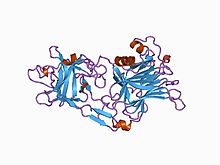
Back تتانوسبازمين Arabic Tetanospasmina Catalan Tetanospasmin Czech Tetanospasmin German Tetanoespasmina Spanish Tétanospasmine French Tetanospasmina Galician Tetanospasmin ID Tetanospasmina Italian テタノスパスミン Japanese
| Tetanus toxin | |||||||
|---|---|---|---|---|---|---|---|
 | |||||||
| Identifiers | |||||||
| Organism | |||||||
| Symbol | tetX | ||||||
| Entrez | 24255210 | ||||||
| RefSeq (Prot) | WP_011100836.1 | ||||||
| UniProt | P04958 | ||||||
| Other data | |||||||
| Chromosome | Genomic: 0.07 - 0.07 Mb | ||||||
| |||||||
| Tentoxilysin | |||||||||
|---|---|---|---|---|---|---|---|---|---|
| Identifiers | |||||||||
| EC no. | 3.4.24.68 | ||||||||
| CAS no. | 107231-12-9 | ||||||||
| Databases | |||||||||
| IntEnz | IntEnz view | ||||||||
| BRENDA | BRENDA entry | ||||||||
| ExPASy | NiceZyme view | ||||||||
| KEGG | KEGG entry | ||||||||
| MetaCyc | metabolic pathway | ||||||||
| PRIAM | profile | ||||||||
| PDB structures | RCSB PDB PDBe PDBsum | ||||||||
| |||||||||


Tetanus toxin (TeNT) is an extremely potent neurotoxin produced by the vegetative cell of Clostridium tetani[1] in anaerobic conditions, causing tetanus. It has no known function for clostridia in the soil environment where they are normally encountered. It is also called spasmogenic toxin, tentoxilysin, tetanospasmin, or tetanus neurotoxin. The LD50 of this toxin has been measured to be approximately 2.5–3 ng/kg,[2][3] making it second only to the related botulinum toxin (LD50 2 ng/kg)[4] as the deadliest toxin in the world. However, these tests are conducted solely on mice, which may react to the toxin differently from humans and other animals.
C. tetani also produces the exotoxin tetanolysin, a hemolysin, that causes destruction of tissues.[5]
- ^ "Tetanospasmin" at Dorland's Medical Dictionary
- ^ "Pinkbook | Tetanus | Epidemiology of Vaccine Preventable Diseases". CDC. Retrieved 2017-01-18.
- ^ "Toxin Table". Environmental Health & Safety » University of Florida. Archived from the original on 2017-01-18. Retrieved 2017-01-18.
- ^ "Botulism". World Health Organization. Retrieved 2017-01-18.
- ^ Willey J (2009). Prescott's Principles of Microbiology. New York City, NY: McGraw-Hill. pp. 481. ISBN 978-0-07-337523-6.